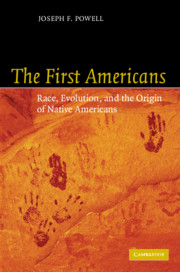Book contents
- Frontmatter
- Contents
- Acknowledgments
- Prologue: The Kennewick controversy
- PART I Race and variation
- PART II The Pleistocene peopling of the Americas
- PART III The First Americans, race and evolution
- 9 Racial models of Native American origins
- 10 Evolutionary models of Native American origins
- 11 The First Americans: Native American origins
- References
- Index
11 - The First Americans: Native American origins
Published online by Cambridge University Press: 21 August 2009
- Frontmatter
- Contents
- Acknowledgments
- Prologue: The Kennewick controversy
- PART I Race and variation
- PART II The Pleistocene peopling of the Americas
- PART III The First Americans, race and evolution
- 9 Racial models of Native American origins
- 10 Evolutionary models of Native American origins
- 11 The First Americans: Native American origins
- References
- Index
Summary
TRADITIONAL VIEWS OF THE PEOPLING OF THE AMERICAS
Most researchers studying the peopling of the Americas are presented with a simple explanation for how humans came to the Americas from east Asia. At first, like most who hear the story, I was a true believer and never doubted the veracity of this traditional anthropological tale, which is still taught to university undergraduates and anthropology graduate students around the world:
All Native Americans trace their biological and cultural roots to one or more groups of Late Pleistocene (Upper Paleolithic) hunters from northeast Asia who migrated to North America across the Bering Land Bridge in pursuit of giant mammals that provided their sustenance. Once in Alaska, these intrepid hunters rushed south through an Ice-Free Corridor between two massive ice sheets, and in the process created a new set of stylized tools, later to be called Clovis, Fishtail, and later, Folsom. The hunters then spread across the whole of North and South America and hunted their prey to extinction. These ancient hunters left behind descendants who learned to cultivate plants, and build towns, cities, chiefdoms, and kingdoms, which then collapsed in the wake of European contact and colonization. The descendants of the ancient hunters were greatly reduced in number by epidemic disease, but now number in the millions. They were pushed off their traditional homelands and were forced onto reserves and often forced to accept new languages, religious beliefs, and cultural practices.
- Type
- Chapter
- Information
- The First AmericansRace, Evolution and the Origin of Native Americans, pp. 229 - 236Publisher: Cambridge University PressPrint publication year: 2005



